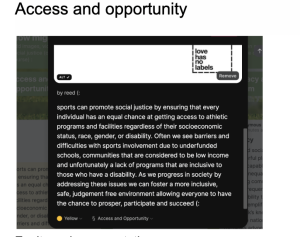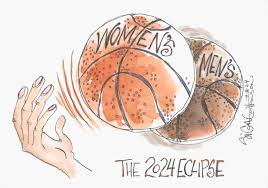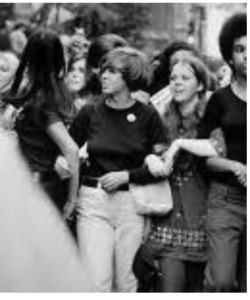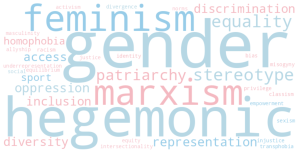1
Section One: The Fundamentals
A) What do we know about sport? What are common assumptions we make about sport and society?
its not showing up… but the answers are :
1.sports builds character
2. sport provides opportunity for social mobility
3. sport reflects values and social norms
4. sport encourages team work and unity
5. sport transcends politics
6. sport speaks a universal language
7. sport is a measure of individual merit
While I believe that sports promote social mobility it may not be fully accessible for everyone. Those who struggle or have economic barriers may not have the same sports opportunities or resources others may have. Money , equipment, travel and private coaching creates economic barriers for those who may struggle financially. We often also see structural inequalities as well, due to historical, cultural or certain demographics we see that some sports do not allow for equal upward mobility, making it limiting to others who are apart of these subgroups. Lastly we often see that connections can sometimes overpower or overshadow raw talent and ability not making it totally accessible to just anyone.

Exercise 3: Notebook prompt
What are some other metanarratives about sport that you are familiar with? Find an image or video clip or draw something yourself that captures this idea…
So what? Why does any of this matter? Does it matter? As something we grow up with – live with – play through – we don’t often interrogate the meanings of sport, and perhaps we don’t want to.
But being aware of these assumptions and metanarratives is especially important, I would argue, because of the centrality of sport to our everyday lives, the role that sport plays in shaping our childhood and worldviews and….. [finish that thought]
|
There are various kinds of meta narratives about sports, there is that sports build character, hard or always wins , lastly the level playing field, lastly that sports bring people and communities together. The idea that sports build character is one that I’ve heard since a young age, in elementary school and high school it was a phrase that was often used in gym class. While sports serve as a communal tool to teach discipline and teamwork that often have negative impacts on children like creating unhealthy mindsets towards body image , their peers , aggression, exclusion and being overly competitive. Another one is “ the level playing field” this is in reference to all athletes play under equal conditions but fails to take into account a lack of resources for sports and biological differences such as genetic mutations that aid in sport advantages. Hard work always wins is the idea that if you put in effort you are always a winner but this is not necessarily true, in society we often place winning in a title or a physical object, this phrase doesn’t account for genetic differences, economic priveliage and access to training. Lastly an idea I want to touch on is that sports bring communities together, while this can be true, those who do not have access to resources or have the funds to participate are often excluded. This in a sense can drive a community apart because it doesn’t allow for everyone to have an equal chance to be involved. These meta narratives are so important to be aware of especially in childhood because often as children we internalize information and don’t have the ability to take things metaphorically rather just take everything literally. These narratives can influence how we see ourselves and others and can result in overlooking structural inequalities in sports and society. Awareness is key because we can learn to grow and progress away from these narratives and take a new and healthy approach to sports. that is a link to a ted talk about a man and his childhood playing sports with a coach who had a win at all costs mindset
|
B) What is social justice?
Exercise 4: Padlet Prompt
Think back to the last section and try to look at some of the ideas we discussed differently. How might sport and social justice actually co-exist?
Record any images, video clips, or gifs you added to the padlet and identify a point of intersection between sport and social justice (can be an issue or a barrier or a debate or something you would like to explore in more depth in this course) . Screenshot or paste in your response below.
| representation and equity Representation and equity at all levels of sports including coaches, athletes or professionals is critical to achieving social justice. Previously in history we have seen inequalities in sports especially with women, the LGBTQ communities and other racial minorities. These communities have been subjected to exclusion, doubts in capabilities or even underrepresentation in key roles in sports. As society didn’t allow for diverse teams and sports we saw a lack of opportunities for individuals in these groups of people preventing them from being included in sports. we often hear how joining a sport can help individuals to gain a better understanding of team work, sportsmanship, leadership and other qualities that can aid someone through life, but not having an equal playing field for these groups of individuals can impact growth, self esteem and result in issues with confidence.For example historically we have seen that women were not allowed to participate in leadership roles in sports this could be coaches, team owners etc. Now this is beginning to change, we see more and more women in leadership roles and breaking through social barriers, while the progress is slow there is still progress. Although these challenges still remain a huge challenge for the LGBTQ community where people within this community are often subject to stigma and a lack of acceptance. This can impede an individuals growth, affect self esteem and ultimately discourage someone from participating in sports. To achieve any kind of equity in sports we need to push for systemic changes including mentorship programs for these underrepresented groups of people to promote diversity and be more inclusive.Advocacy and activismAthletes and organizations will often use their platforms to promote and advocate for societal change. We saw this when Colin Kaepernick was kneeling or taking a knee to protest against racial injustice. This occurred September 1st 2016 Kaepernick took a knee during the NFL preseason which lead to a series of national anthem protests across the sports world. His actions lead to an amplification of important social justice movements and highlighting the need to advocate for the groups that are underrepresented and raise awareness about the broader systemic issues these communities face. His actions were not only a moment in time but a whole movement, he inspired so many athletes in all sports leagues to join in unity and use the power of sports as a positive platform for societal change. He unfortunately received a lot of backlash for this movement, but in all the backlash he opened a conversation amongst everyone that raised awareness about racial inequalities in sports and in general.Community engagementSports have the ability to bring communities together and foster a stronger sense of community and trust, promoting social cohesion. Community based sports can act as a tool for promoting inclusivity, bringing people of all ages together and build each others confidence. community based sports is so important now that social media and the internet have become such a great part of peoples daily lives especially the youth. Engaging the youth in sports can help to remind them that what they see on social media isn’t always reality . When you are constantly engaging in online content you are subject to being exposed to negative content that has the ability to influence vulnerable minds.I myself play sports, I play for the lady blue knights lacrosse team in Whitby and I love it so much especially my team. In more recent years at Trent ive stepped out of my comfort zone a little and played for the intramural volleyball team and it truly helped with my confidence and taught me that i am capable of trying new things and succeeding. My team mates were so encouraging and so kind, I made 12 new friends the day I joined that team and im forever grateful. Although community based sports are amazing, they are not always accessible to everyone, which can create a barrier and divide in communities. Making sports accessible to everyone including social groups and racial groups ( fostering a safe environment for anyone regardless of gender, race, disability or sexual orientation ) can truly impact how we progress in society. 
|
C) Social Justice Reading
(note: this activity is optional!)
D) KINESIOLOGY AND SOCIAL JUSTICE
Exercise 5:
Exercise 6:
What are the implications of bodies-at-risk discourse and the refusal to understand the health gap from a social justice perspective, according to the authors of this article?
| The implications of the bodies at risk disclosure and the refusal to understand the health gap from a social justice perspective, according to the authors touches on the maintenance of having inequalities of low health and oppression. It is evident that there is a lack of searching for the true root cause of these inequalities and oppression, and rather than finding the root cause and a solution the blame is placed onto another group of individuals instead of taking accountability. Racism is an example of this, individuals who are subjected to racism are often blamed for certain stereotypes and there are justifications that are made for those who think in a racist manner, rather than taking accountability and trying to learn and change the group of individuals that are oppressed are often blamed. It is also important that we reflect upon historic instances where oppression and racism has occurred against marginalized groups. Rather than taking accountability and searching for solutions people will often try to place blame else where rather than taking accountability. An example of this is indigenous peoples, they have had so many disadvantages historically and since there is a lack of accountability we still see these disadvantages today.
|
Section Two: Sport Feminism
Exercise 7: Notebook Prompt
What is feminism? What does it mean to you? Choose one of the images below and explain how it captures your understanding of feminism (or find one that does speak to you and paste this into your pressbook with an explanation of why it matters to you.
|
Feminism is about all genders having equal rights. Specifically feminism is about respecting women and their diverse experiences, identity, culture, abilities, strengths and knowledge. Its about empowering women to be the best they can and accepting them for who they are and ensuring women have equal opportunities to other genders. This photo shows three women and what looks like to be a man on the right hand side, and they are all walking in unity. They are linked by the arms in a sense showing a strong chain or is symbolic of solidarity, resilience and having a similar objective. The linked arms represent community and its making a statment, specifically saying they are in this together and that they accept each other. It looks as though they could be in potentially a protest or a movement to advocate for equality, womens rights and societal change. We can see there are all races, genders and such at this movement showing that everyone can be equal, everyone should be accepted and loved for who they are, this shows that no one is lesser than another irrespectable to any disability, any race, gender, culture etc. This is important to me as a woman because it is important that everyone gets an equal chance in life, and we are in dire need for societal change.
|
Exercise 8: Notes Prompt (optional)
NB: Cornell notes is a great resource that teaches effective notetaking. Unfortunately, our system can’t save notes taken in the H5P app, so this is fully optional.
Exercise 9: Crossword Activity
Exercise 10: Padlet Prompt
|
This word cloud represents all the key terms and concepts related to social justice and gender studies. Some of the words like feminism, equity, oppression and intersectionality shed light on societal and structural inequalities.
|

|
|



